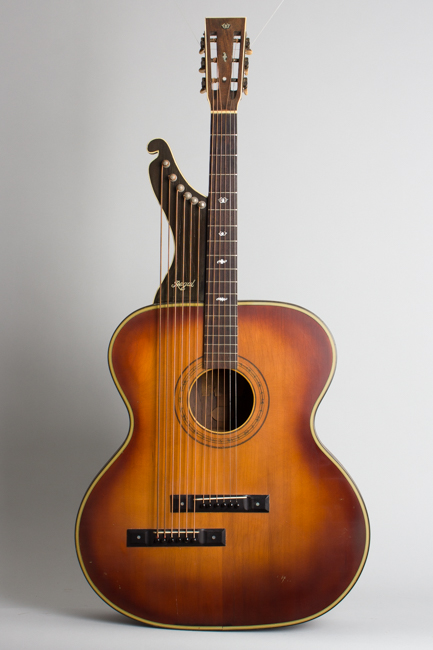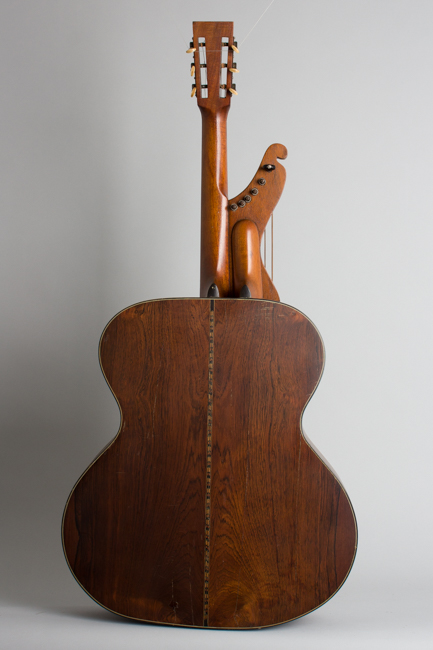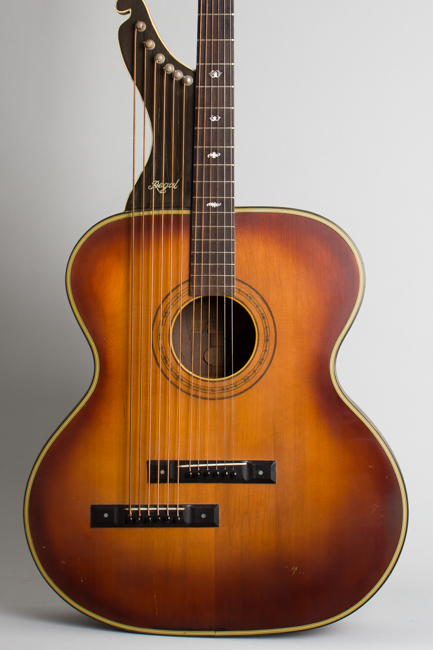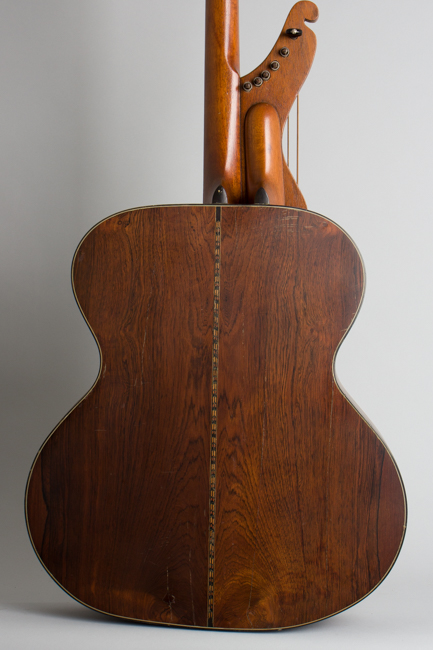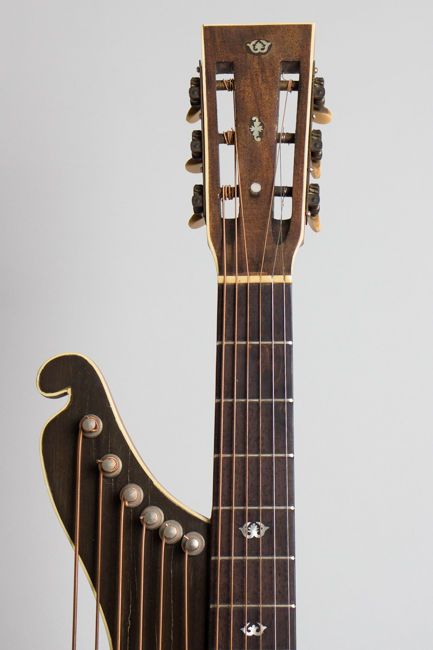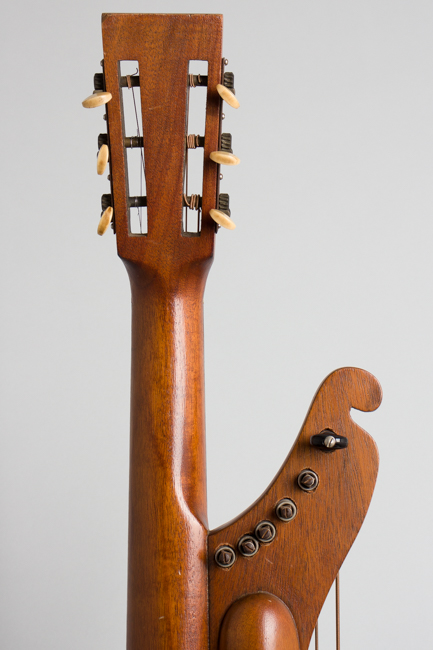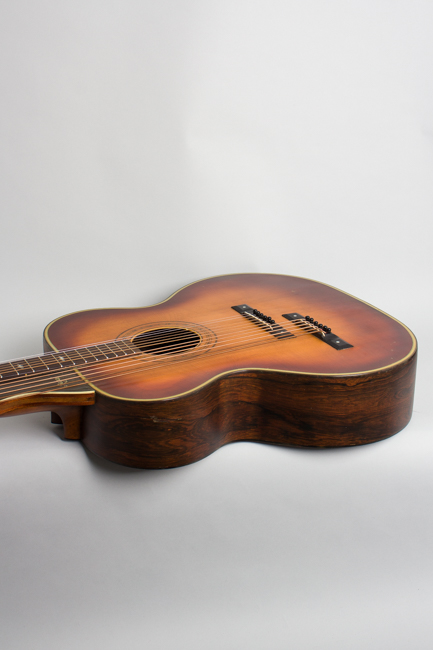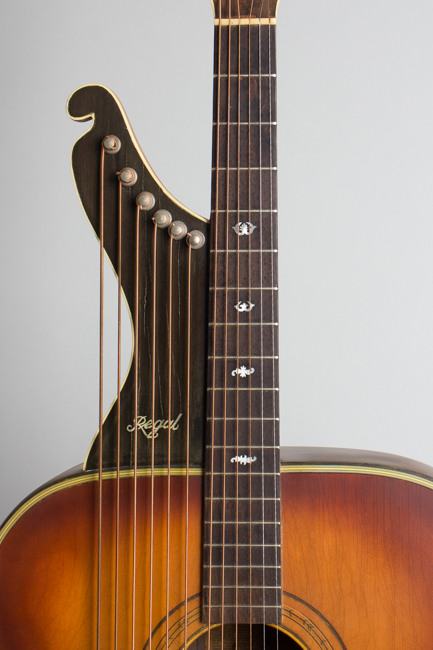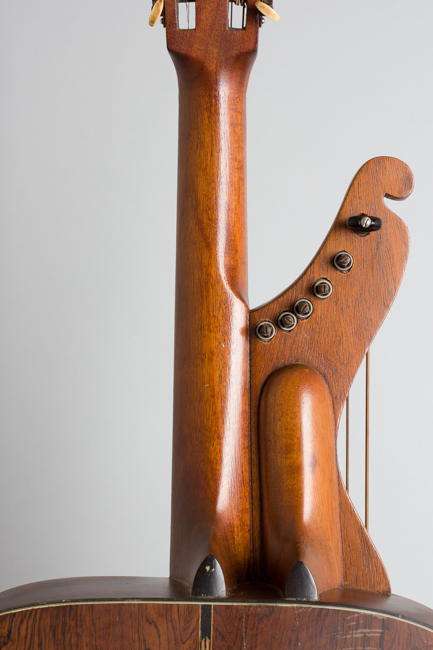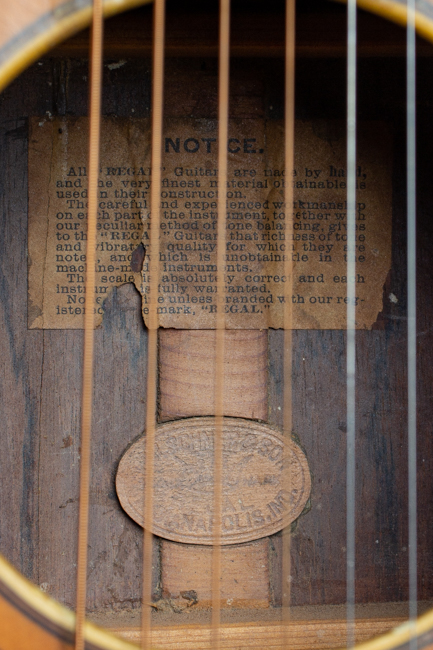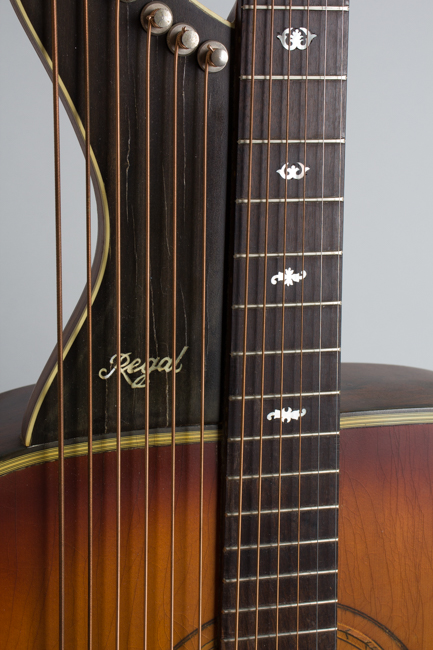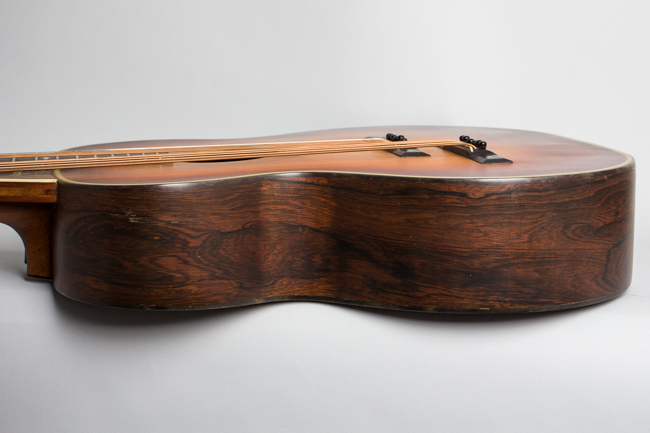Regal Contra Bass Harp Guitar, made by Wulschner , c. 1900
Regal Contra Bass Model Harp Guitar, made by Wulschner, c. 1900, made in Indianapolis, Indiana, serial # 9994, sunburst top, natural back and sides finish, rosewood back and sides, spruce top; mahogany neck with rosewood fingeroard.
This spectacular and super striking harp guitar has had a bit of a checkered history to this point, but has survived over 120 years as a playable conversation piece, at the very least! It was built by the original Regal company of Indianapolis (the ancestor of the more familiar Chicago firm) right around 1900. That firm was out of business completely by 1904, and this unique design has never been repeated since. At some point along the way the body was refinished with a sunburst top, something pretty much unknown when it was made. The guitar was part of the famous Chinery Collection for a time, pictured on page 29 of the 1996 book documenting that assembly of instruments.
The now obscure Wulschner & Sons of Indianapolis were the original owners of the Regal tradename, active just before the turn of the 20th century. By 1900 the brand was already in flux, re-organized several times before 1904. After that the name was sold to Lyon & Healy, then reborn an independent Chicago company in the early 1920s. While later Regals are mostly remembered as budget-brand instruments, these first Indianapolis made instruments are fine quality pieces, comparable to many of the better guitars of the period. This one has both a paper label and pressed wooden disc under the soundhole proclaiming as much! The label reads in part "All Regal guitars are made by hand and the very finest material obtainable is used". Looking at the heavily figured rosewood and tight grain spruce on the top they were not kidding!
There are a small number of these very large Regals surviving in the 21st century, of which this is the best known example. As noted the sunburst top is not an original feature, but now makes this a one-of-a-kind piece. The enormous rosewood body is over 19" wide, and 4" deep as well; that's a LOT of Brazilian there! The spruce top is multi-bound and braced in a modified "A" pattern with a very large bridgeplate which has kept it solid for well over a century. The eccentric and distinctive design has a separate solid upper body extension holding the sub bass tuners instead of a second neck or Knutson-style hollow extension.
The mahogany neck is substantial but round-backed, not the "V" shape common in this period and more comfortable for it. The rosewood fingerboard is unbound with small shaped pearl inlay, the headstock is bound with similar ornament. The "Regal" logo is inlaid in pearl script on the face of the harp extension, which is also bound. This is a huge sounding guitar, with plenty of volume and a very deep resonance. The sub-bass strings are shorter than many harp guitars; while not as strong alone as some designs they do a nice job of resonating sympathetically when the guitar is played, adding an extra element to the sound. Eccentric for sure, but this is actually a very nice instrument and despite its size handier and better balanced than many harp guitars.
Overall length is 40 in. (101.6 cm.), 19 1/4 in. (48.9 cm.) wide at lower bout, and 4 1/2 in. (11.4 cm.) in depth at side, taken at the end block. Scale length is 24 3/4 in. (629 mm.). Width of nut is 1 11/16 in. (43 mm.).
As noted this guitar has seen a lot of work over the last 120+ years, but remains a fully playable piece. The body was refinished long ago in a matte lacquer with a shaded sunburst on the top and natural rosewood on the back and sides; the finish on the neck remains original with some checking, while the harp extension was also refinished but possibly at a different time.
There are several long sealed cracks in the rosewood back, looking to have been first repaired long ago before the finish work. There is some light flaking, mostly along the backstrip. The sides have a few old sealed cracks as well, the massive top has only a couple of tight grain splits off the back edge and is amazingly flat and true. The ebony bridges appear original, or very old replacements if not. They have been reglued in any case. The frets also appear original, of if replaced again it was done long ago. They show only minimal wear.
The tuners for the harp strings were re-worked at some point; they are banjo style friction pegs without buttons (except for the lowest one) and require a banjo or zither style wrench to tune. This is not particularly convenient but they do hold tune decently once gotten to pitch. This is wonderful sounding guitar, even ignoring the harp strings which even unused add a sort of subliminal depth. Based on period photographs several prominent vaudeville players used this style of instrument well over a century ago, when it was one of the largest and most visually impressive guitars available. It still makes quite an impression today, both aesthetically and sonically! Very Good + Condition.
This spectacular and super striking harp guitar has had a bit of a checkered history to this point, but has survived over 120 years as a playable conversation piece, at the very least! It was built by the original Regal company of Indianapolis (the ancestor of the more familiar Chicago firm) right around 1900. That firm was out of business completely by 1904, and this unique design has never been repeated since. At some point along the way the body was refinished with a sunburst top, something pretty much unknown when it was made. The guitar was part of the famous Chinery Collection for a time, pictured on page 29 of the 1996 book documenting that assembly of instruments.
The now obscure Wulschner & Sons of Indianapolis were the original owners of the Regal tradename, active just before the turn of the 20th century. By 1900 the brand was already in flux, re-organized several times before 1904. After that the name was sold to Lyon & Healy, then reborn an independent Chicago company in the early 1920s. While later Regals are mostly remembered as budget-brand instruments, these first Indianapolis made instruments are fine quality pieces, comparable to many of the better guitars of the period. This one has both a paper label and pressed wooden disc under the soundhole proclaiming as much! The label reads in part "All Regal guitars are made by hand and the very finest material obtainable is used". Looking at the heavily figured rosewood and tight grain spruce on the top they were not kidding!
There are a small number of these very large Regals surviving in the 21st century, of which this is the best known example. As noted the sunburst top is not an original feature, but now makes this a one-of-a-kind piece. The enormous rosewood body is over 19" wide, and 4" deep as well; that's a LOT of Brazilian there! The spruce top is multi-bound and braced in a modified "A" pattern with a very large bridgeplate which has kept it solid for well over a century. The eccentric and distinctive design has a separate solid upper body extension holding the sub bass tuners instead of a second neck or Knutson-style hollow extension.
The mahogany neck is substantial but round-backed, not the "V" shape common in this period and more comfortable for it. The rosewood fingerboard is unbound with small shaped pearl inlay, the headstock is bound with similar ornament. The "Regal" logo is inlaid in pearl script on the face of the harp extension, which is also bound. This is a huge sounding guitar, with plenty of volume and a very deep resonance. The sub-bass strings are shorter than many harp guitars; while not as strong alone as some designs they do a nice job of resonating sympathetically when the guitar is played, adding an extra element to the sound. Eccentric for sure, but this is actually a very nice instrument and despite its size handier and better balanced than many harp guitars.
Overall length is 40 in. (101.6 cm.), 19 1/4 in. (48.9 cm.) wide at lower bout, and 4 1/2 in. (11.4 cm.) in depth at side, taken at the end block. Scale length is 24 3/4 in. (629 mm.). Width of nut is 1 11/16 in. (43 mm.).
As noted this guitar has seen a lot of work over the last 120+ years, but remains a fully playable piece. The body was refinished long ago in a matte lacquer with a shaded sunburst on the top and natural rosewood on the back and sides; the finish on the neck remains original with some checking, while the harp extension was also refinished but possibly at a different time.
There are several long sealed cracks in the rosewood back, looking to have been first repaired long ago before the finish work. There is some light flaking, mostly along the backstrip. The sides have a few old sealed cracks as well, the massive top has only a couple of tight grain splits off the back edge and is amazingly flat and true. The ebony bridges appear original, or very old replacements if not. They have been reglued in any case. The frets also appear original, of if replaced again it was done long ago. They show only minimal wear.
The tuners for the harp strings were re-worked at some point; they are banjo style friction pegs without buttons (except for the lowest one) and require a banjo or zither style wrench to tune. This is not particularly convenient but they do hold tune decently once gotten to pitch. This is wonderful sounding guitar, even ignoring the harp strings which even unused add a sort of subliminal depth. Based on period photographs several prominent vaudeville players used this style of instrument well over a century ago, when it was one of the largest and most visually impressive guitars available. It still makes quite an impression today, both aesthetically and sonically! Very Good + Condition.
